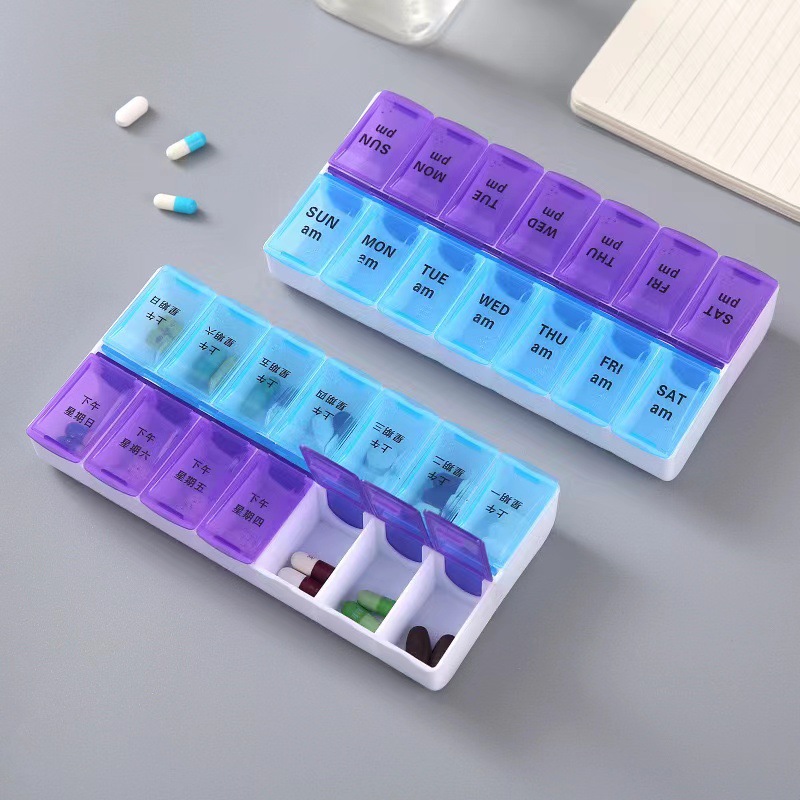In modern life, plastic pill boxes have become a convenient tool for many people to manage their medications. They are compact, lightweight, and easy to carry, allowing users to neatly organize daily doses. However, concerns about the potential harm of plastic pill boxes to human health have also emerged. To understand the risks, it is essential to examine the types of plastics used and how they might interact with medications and the human body.
Types of Plastics and Their Risks
Plastic products are made from a variety of polymers, and different types have distinct properties and potential health impacts. The most common plastics used in consumer products, including pill boxes, are polypropylene (PP) and polyethylene (PE). These plastics are generally considered safe for medical and food - contact applications when used within recommended temperature ranges. They are resistant to chemicals and have relatively low permeability, which helps prevent the migration of external substances into the contents.
On the other hand, plastics like polyvinyl chloride (PVC) contain additives such as phthalates, which are plasticizers used to increase flexibility. Phthalates have been linked to various health issues, including hormonal disruption, especially when they leach out of the plastic. Although PVC is less commonly used in pill boxes due to its potential risks, some low - quality or unregulated products might still utilize it. Another concern is bisphenol A (BPA), which was widely used in polycarbonate plastics in the past. BPA has been associated with developmental problems, endocrine disruption, and other health problems. However, many manufacturers have now switched to BPA - free alternatives.
Factors Affecting Plastic Safety
Several factors can influence whether plastic pill boxes pose a risk to human health. Temperature is a significant factor. High temperatures, such as leaving a pill box in a hot car or exposing it to direct sunlight for an extended period, can cause plastics to break down and potentially release harmful chemicals. For example, if a plastic pill box made of a less - stable polymer is exposed to high heat, the chemical bonds within the plastic may weaken, allowing substances to leach into the medications stored inside.
The nature of the medications themselves can also play a role. Some medications may be more reactive with plastics than others. For instance, certain acidic or alkaline drugs could potentially interact with the plastic surface over time, leading to the degradation of the plastic or the absorption of plastic components by the drugs. Additionally, the duration of storage matters. Long - term storage of medications in plastic pill boxes may increase the likelihood of chemical leaching, especially if the box is not of high quality or if it is repeatedly opened and closed, causing microscopic damage to the plastic.
Minimizing the Risks
To reduce the potential harm associated with using plastic pill boxes, consumers can take several precautions. First, choose pill boxes made from high - quality, food - grade plastics, preferably those labeled as BPA - free, phthalate - free, and approved for medical use. Look for products from reputable manufacturers that adhere to strict safety standards. Second, avoid exposing pill boxes to extreme temperatures. Keep them in cool, dry places, away from direct sunlight and heat sources. If traveling in hot weather, consider using an insulated bag to protect the pill box and its contents.
Regularly clean the pill box to prevent the buildup of bacteria and other contaminants. Use mild, non - abrasive cleaners and avoid harsh chemicals that could damage the plastic. Additionally, replace the pill box periodically, especially if it shows signs of wear and tear, such as cracks, discoloration, or a change in texture. This can help ensure that the plastic remains in good condition and less likely to release harmful substances.
In conclusion, while plastic pill boxes offer great convenience, there are potential health risks associated with their use. By understanding the types of plastics, the factors that affect their safety, and taking appropriate preventive measures, consumers can use plastic pill boxes more safely and continue to benefit from their organizational advantages in managing medications.

Contact: Eileen
Phone: 18329191950
E-mail: info@scicarebio.com
Whatsapp:
Add: NO.3880 JIANGNAN ROAD BINJIANG DISTRICT , HANGZHOU,ZHEJIANG PRO, CHINA
We chat
